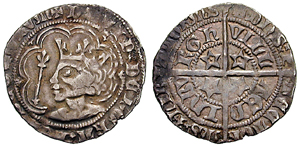Groat (coin) facts for kids
 |
|
| A silver groat from the reign of Edward I of England (1272–1307) |
The groat was an old silver coin used in England, Ireland, and Scotland. In England and Ireland, it was usually worth four pence. Scottish groats started at four pence but later became worth more, like eight pence or even one shilling.
Contents
What's in a Name? The Groat's Meaning
The word "groat" comes from words meaning "large" or "great." This is because the groat was a bigger coin than many others at the time. For example, the French gros tournois was a similar large coin. In the Netherlands, it was called groot, which means "great" or "large."
Many other European coins also had names similar to groat. These included the grosso in Italy, like the grosso of Venice. There was also the Kraków grosz in Poland. Even the famous traveler Marco Polo wrote about coins called groats. He used the name when describing money in the Yuan Dynasty in East Asia.
The Groat's Journey Through History
| Edward III | |
|---|---|
 |
|
| Minted: London, Series: B, Years Minted: 1351 - 1361 (Courtesy of Guillelmus Thompson, Owner of Coins of Britannia) |
| Elizabeth I: Irish groat | |
|---|---|
 |
|
| ELIZABETH·D·G·ANG·FRA·Z·HIB:REGIN (Elizabeth by the Grace of God, of England, France and Ireland Queen) | POSVI·DEV·ADIVTOREM·MEV (I have made God my helper) |
| AR Groat (2.82 g). | |
The first English groat was made during the time of King Edward I. This happened after French silver coins of a similar size became common in England.
Scottish groats were not made until later, during the reign of David II. These early Scottish groats were also worth four pence. But over time, their value changed. Later Scottish groats were worth eight pence or even a full shilling.
Irish groats began to be minted in 1425. The very last regular Irish groats were made during the reign of Elizabeth I of England. There were also a couple of special issues during emergencies.
Changes in Weight and Value
The value of the English groat was linked to its silver content. In the 12th century, the pound sterling (worth 240 pence) was based on a certain amount of pure silver. This meant an English groat, worth four pence, contained about 5.8 grams of silver.
However, the weight of the groat slowly became lighter over the years.
- In 1351, under Edward III, it weighed about 4.7 grams.
- By 1412, under Henry IV, it was about 3.9 grams.
- In 1464, under Edward IV, it weighed about 3.1 grams.
From 1544 to 1560, the silver in the groat was not as pure. After 1561, groats were not usually made for everyday use for about 100 years.
Later Groats and Their End
From the time of Charles II to George III, groats were sometimes made. They were often called "fourpences" by then. After 1786, they were only made in 1792, 1795, and 1800.
Later, from 1836 to 1855, some groats were made for general use. These coins were even lighter, weighing about 1.9 grams. They were the same size as the silver threepenny coins but thicker. These later groats had Britannia on one side. Other silver fourpenny coins, since the time of William and Mary, showed a crowned number "4." This design is still used on the silver fourpenny Maundy money coins today. Some groats were still used in Scotland until the 1900s.
Sometimes, silver twopenny coins were called "half-groats."
The groat stopped being made in the United Kingdom in 1856. However, in 1888, a special version was made for use in British Guiana and the British West Indies. The groat was used in British Guiana until 1955, when they started using a decimal money system.
Today, groats are still made as part of special sets of Maundy Coinage. These are given out by the monarch during a special ceremony.
In the 1600s and 1700s, chaplains on English Navy warships were paid in an interesting way. The captain hired them, and their pay came from a small amount (a groat) taken from each sailor's monthly wages. For a long time, from 1653 to 1797, the wages for ordinary sailors and chaplains stayed the same.
See also



